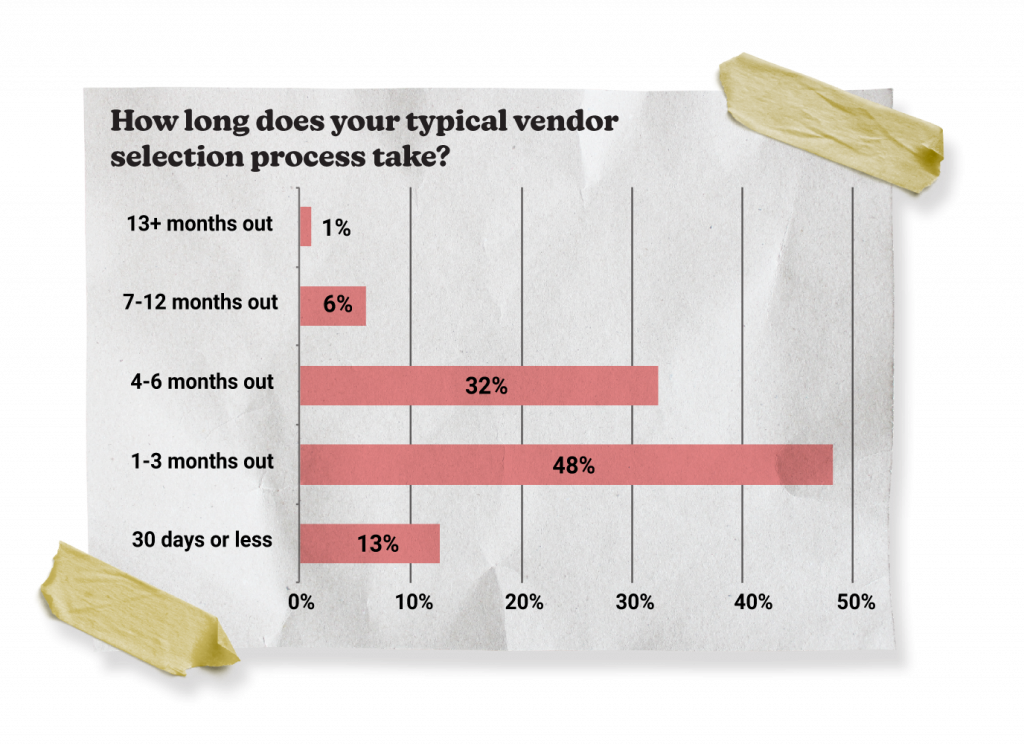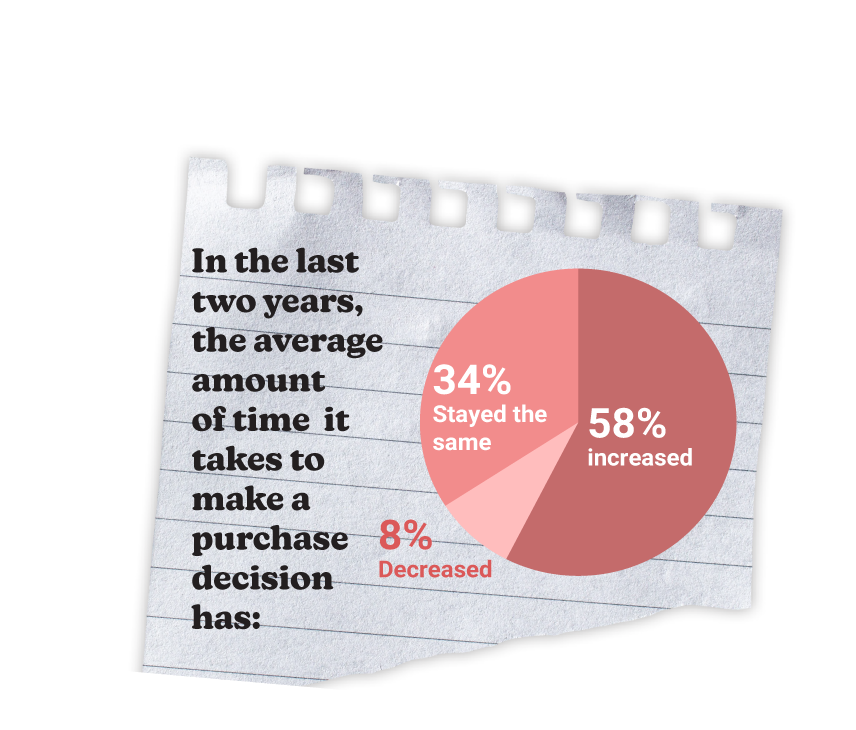
Decoding the real timeline of B2B buying decisions
Published on 30 October, 2024 | Author: Digitalzone
The life of a corporate professional in most B2B industries might look like this: each day is a relentless cycle of meetings, tight deadlines, and crafting compelling pitches. It’s a fast-paced world where decisions are crucial, and the pressure to deliver is constant.
Getting a handle on the buying timeline isn’t just helpful—it’s essential. For B2B marketers, knowing this timeline is crucial for landing those big contracts.
This blog post explores the current dynamics of B2B buyer timelines, drawing on the data from Digitalzone’s B2B Buyer Beat—a comprehensive 2024 report that includes research and survey results from 1,500 decision-makers around the globe.
With those insights, we’ll dive into how long purchase decisions actually take, the biggest timing challenges buyers encounter, and our best strategies to overcome them.
Breaking down the actual buying timeline
In today’s fast-paced business world, you’d think many decisions are made on the fly. Yet, an overwhelming 80% of B2B buyers report that choosing a vendor can take up to six months.

The slow pace of the B2B buying process isn’t merely a delay—it’s a reflection of the intricate web of activities on the buyer’s side. With multiple layers of complexity, from thorough product evaluations to securing stakeholder approvals, buyers and their committees can’t help but move cautiously. This pace is due to numerous dependencies that require careful coordination.
Adding another layer of complexity, it’s worth noting that selecting a vendor doesn’t account for the time needed to budget for that vendor.
According to the survey, 41% of respondents begin budgeting for new vendor purchases 1-3 months in advance, while 35% start the process 4-6 months ahead. This means a significant 76% of buyers may take up to six months just to initiate budgeting, which furthers extends the average buying timeline.
In reality, when 80% of buyers take up to six months to choose a vendor and 76% then require up to another six months to initiate the budgeting process. This means the buying journey—from budgeting to vendor selection—can span a full 12 months for most prospective buyers.

Before we jump to any conclusions about how long purchases take, it’s important to realize that even this timeline is probably going to fluctuate. The survey revealed that buyers feel their decision-making is slowing down, with over half saying it’s stretched out even more in the last couple of years.
This shift will likely continue and so it’s important adapt your expectations to close a deal based around this trending dynamic.
The top challenges B2B buyers face
To navigate the buying process is to maneuver through a maze of time constraints, limited resources, and tight budgets. These aren’t just industry jargon—they’re genuine obstacles.
The survey results highlighted that the top two challenges buyers face are time constraints (24%) and limited resources/budget (26%). So how does this play out in the buying timeline we see today?
Well today’s buyers often find themselves racing against the clock while balancing internal pressures, which creates an ongoing chicken-and-egg scenario. Then, when budgets are tight, every decision requires meticulous consideration to ensure alignment with strategic objectives. Throw in the constantly changing market dynamics and it’s no wonder buyers proceed slowly.
Another timing challenge buyers commonly face comes from external factors beyond their control. When purchase decisions face delays, buyers said 70% of hold-ups stem from external factors like a market shift, bad contract timing with other vendors, and competitive assessment.
Here’s another line item to add to the mounting list of challenges: When buyers set their sights on big-ticket items, the purchasing process tends to hit the brakes. Buyers are twice as likely to take over six months to finalize a decision for expensive purchase.
For marketers, understanding these timeline hurdles could be the breakthrough your demand generation strategy needs. Recognizing these significant challenges provides the crucial insights required to effectively shape how you position your offerings. It sets the stage for how you engage with prospects and leads, ensuring your approach is both relevant and impactful.
The timing of money
Now that we’ve established the challenges facing buyers, how do we overcome them?
Well, here’s a conversation starter: The survey highlighted that 46% of B2B buyers work within an annual budget. This insight underscores a major point—financial considerations drive purchasing decisions because each trigger is tied to perceived value.
However, predicting when these financial considerations will occur is practically impossible. There’s no magic calendar to reveal when a buyer’s organization will finalize their annual budget, nor can marketers foresee when a vendor might underperform.
The critical question extends beyond merely determining “when” to engage but rather, “how” to engage these humans who are in a highly unpredictable environment. To effectively pinpoint the “right moments” for engagement, it’s essential to actively gather insights from your leads.
This valuable intel can be collected through strategies such as:
- Developing robust email surveys
- Incorporating BANT questions into forms
- Engaging conversations at in-person events
- Interactive social media posts (polls, votes, etc.) or webinars
- Creating content assets that cater to all stages of the sales funnel
By understanding their status and the events they’re navigating—such as vendor reviews or annual budgeting periods—you can seamlessly integrate this knowledge into your marketing strategy for optimal results.
Take things further with an always-on approach
Adopting an “always-on” marketing strategy is a smart move when timelines aren’t clear since it keeps your brand in the periphery of buyers, making it easier for them to reach out when they’re ready to purchase.
An effective always-on marketing strategy might include:
- Display ads
- Content syndication
- Regularly published blog posts
- An active social media presence
- Email newsletters and nurture
Ultimately, being prepared and consistently present is essential to aligning with the buyer’s journey and capturing those pivotal moments of decision.
Buyers (and their timing) is complex
The buying timeline is so much more than a sequence of events. It’s essential to recognize that B2B buyers are real people in real situations, each facing unique challenges and opportunities.
For marketers, the mission is clear: become an indispensable partner to those people navigating this journey.
Given the complexity of human behavior, your marketing strategy should reflect this understanding. By staying informed, adaptable and ready to engage at the right moments, you’ll position yourself as a trusted guide in the buyer’s decision-making process at every part of their journey.
Enjoyed this topic and interested in learning more about the modern buyer? Check out the B2B Buyer Beat to get a deeper understanding of what’s driving buyers today.
